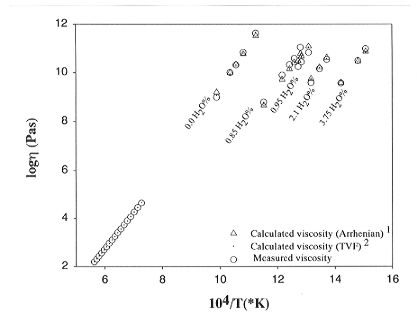

The welding of volcanic glasses is a subject of great importance in modern volcanology because the physical and chemical properties of the volcanic sequence are strongly influenced by the welding process, yielding consequences for their alteration, for volcanic edifice stability, and for resultant hydrology. Welding is essentially a stress relaxation phenomenon that may be accompanied by significant diffusion (chiefly of water), and surface modification via resorption of bubbles and possibly crystal growth. The kinetics of welding is therefore essentially controlled by an interplay of three variables, load, viscosity and time. The loading conditions are usually relatively easy to estimate, based on stratigraphy. Timescales can sometimes be accessed via geospeedometry on welded sequences. Estimation of the viscosity depends essentially on three variables, two of which, chemical composition and water content, can often be measured and the third, temperature, which must be estimated.
Quantification of welding temperature estimates relies on an accurate
knowledge of the relationship between temperature, composition, water content
and viscosity. The continuity and constancy of chemical composition for
certain volcanic fields that exhibit a very wide range of welding textures,
makes it worthwhile to perform detailed viscometric investigations of the
melts as a function of water content and temperature. An example of such
a field is formed by the pyroclastic phonolitic products of Teide volcano.
We have determined the viscosities of hydrous phonolitic melts in the range
of viscosity, water content and temperature very near to that where welding
must occur for these melts. These data are presented in Fig. 3.7-9. Also
included in Fig. 3.7-9 are the results of a fit of the the data which has
been parameterised to an analytical function of water content and temperature.
The results show the remarkably low temperatures to which the welding of
melts, just above the glass transition, are possible for phonolitic compositions
(i.e., less than 645°C). Work is currently in progress to compare the
efficiency of welding to be expected in calcalkaline versus phonolitic
volcanic piles under comparable conditions of eruptive temperature and
loading.
 |
|
Fig. 3.7-9: Viscosity-temperature relationships for phonolitic
melts of variable water content. The variation of viscosity with water
content at constant temperature yields a strongly nonlinear relationship
similar in shape to that observed for calcalkaline rhyolite but shifted
to much lower viscosities. The depressed glass transition temperatures
that can be inferred from this figure mean that welding and potentially
rheomorphic remobilization of phonolitic air-fall and lavas should be much
more widespread than in calcalkaline rhyolites erupted at similar temperatures.
|

Tel: +49-(0) 921 55 3700 / 3766, Fax: +49-(0) 921 55 3769, E-mail: bayerisches.geoinstitut(at)uni-bayreuth.de
 Previous page
Previous page